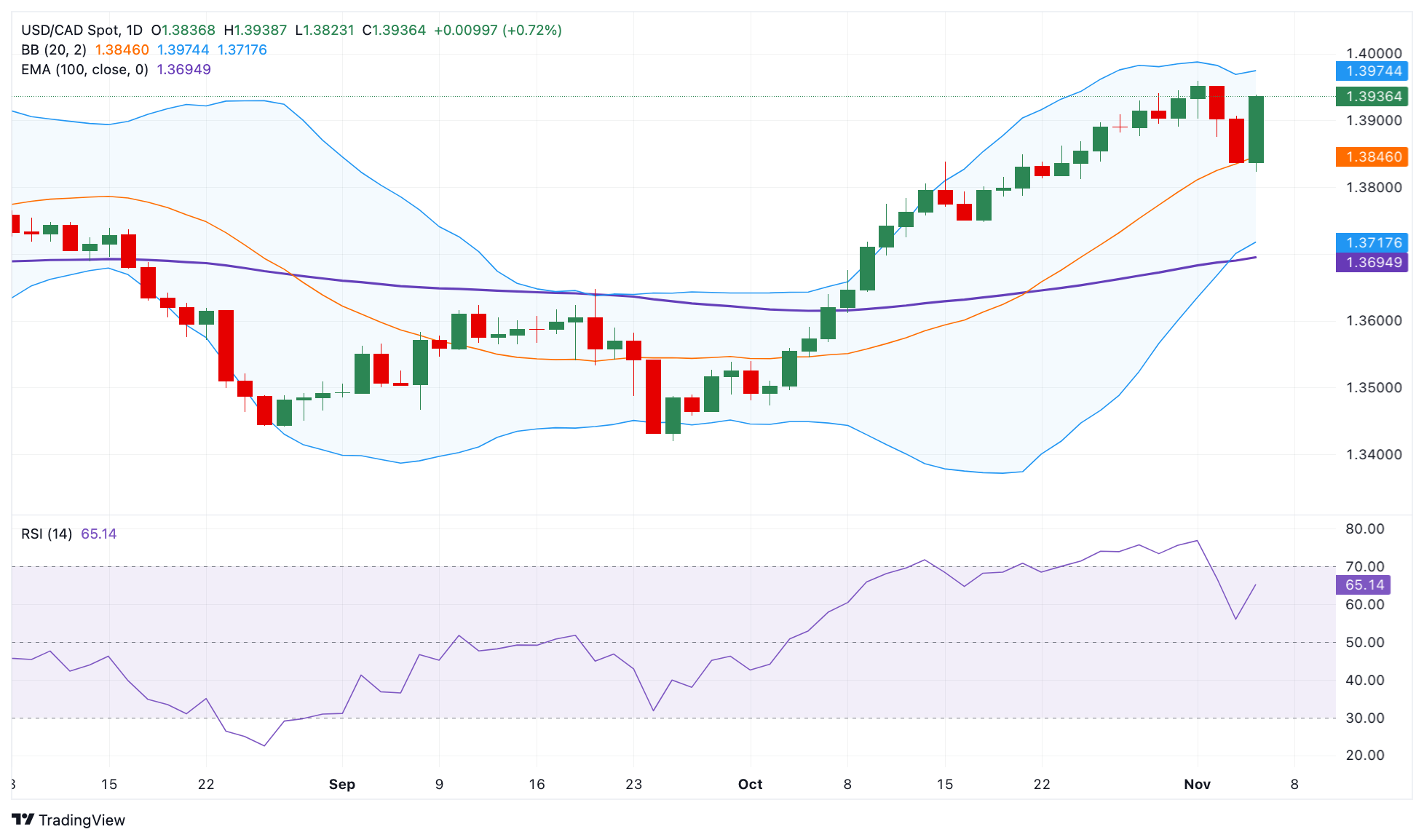- Analytics
- News and Tools
- Market News
- USD/CAD Price Forecast: The pair keeps bullish vibe above 1.3900
USD/CAD Price Forecast: The pair keeps bullish vibe above 1.3900
- USD/CAD strengthens to around 1.3930 in Wednesday’s early European session, adding 0.72% on the day.
- The positive view of the pair prevails above the 100-day EMA and bullish RSI indicator.
- The first upside barrier emerges at 1.3972; the initial contention level is located at 1.3836.
The USD/CAD pair gathers strength to near 1.3930 during the early European session on Wednesday. The US Dollar (USD) rises across the board on the day as Trump trades continue to gain momentum after the polls showed Republican candidate Donald Trump ahead of Democratic candidate Kamala Harris in the US presidential election.
According to the daily chart, USD/CAD keeps a bullish vibe at present as the price is well-supported above the key 100-period Exponential Moving Average (EMA). Furthermore, the upward momentum is reinforced by the 14-day Relative Strength Index (RSI), which stands above the midline near 64.45, indicating that further upside cannot be ruled out in the near term.
Any follow-through buying above the upper boundary of the Bollinger Band at 1.3972 could still lift USD/CAD back up to the 1.4000 psychological mark. A decisive break above this level could attract some buyers to 1.4140, the weekly high of May 11.
On the flip side, the initial support level for the pair is seen at 1.3836, the low of November 5. Extended losses could pave the way to 1.3750, the low of October 16. The key contention level to watch is the 1.3700-1.3695 zone, representing the round figure and the 100-day EMA.
USD/CAD daily chart
Canadian Dollar FAQs
The key factors driving the Canadian Dollar (CAD) are the level of interest rates set by the Bank of Canada (BoC), the price of Oil, Canada’s largest export, the health of its economy, inflation and the Trade Balance, which is the difference between the value of Canada’s exports versus its imports. Other factors include market sentiment – whether investors are taking on more risky assets (risk-on) or seeking safe-havens (risk-off) – with risk-on being CAD-positive. As its largest trading partner, the health of the US economy is also a key factor influencing the Canadian Dollar.
The Bank of Canada (BoC) has a significant influence on the Canadian Dollar by setting the level of interest rates that banks can lend to one another. This influences the level of interest rates for everyone. The main goal of the BoC is to maintain inflation at 1-3% by adjusting interest rates up or down. Relatively higher interest rates tend to be positive for the CAD. The Bank of Canada can also use quantitative easing and tightening to influence credit conditions, with the former CAD-negative and the latter CAD-positive.
The price of Oil is a key factor impacting the value of the Canadian Dollar. Petroleum is Canada’s biggest export, so Oil price tends to have an immediate impact on the CAD value. Generally, if Oil price rises CAD also goes up, as aggregate demand for the currency increases. The opposite is the case if the price of Oil falls. Higher Oil prices also tend to result in a greater likelihood of a positive Trade Balance, which is also supportive of the CAD.
While inflation had always traditionally been thought of as a negative factor for a currency since it lowers the value of money, the opposite has actually been the case in modern times with the relaxation of cross-border capital controls. Higher inflation tends to lead central banks to put up interest rates which attracts more capital inflows from global investors seeking a lucrative place to keep their money. This increases demand for the local currency, which in Canada’s case is the Canadian Dollar.
Macroeconomic data releases gauge the health of the economy and can have an impact on the Canadian Dollar. Indicators such as GDP, Manufacturing and Services PMIs, employment, and consumer sentiment surveys can all influence the direction of the CAD. A strong economy is good for the Canadian Dollar. Not only does it attract more foreign investment but it may encourage the Bank of Canada to put up interest rates, leading to a stronger currency. If economic data is weak, however, the CAD is likely to fall.
© 2000-2024. All rights reserved.
This site is managed by Teletrade D.J. LLC 2351 LLC 2022 (Euro House, Richmond Hill Road, Kingstown, VC0100, St. Vincent and the Grenadines).
The information on this website is for informational purposes only and does not constitute any investment advice.
The company does not serve or provide services to customers who are residents of the US, Canada, Iran, The Democratic People's Republic of Korea, Yemen and FATF blacklisted countries.
Making transactions on financial markets with marginal financial instruments opens up wide possibilities and allows investors who are willing to take risks to earn high profits, carrying a potentially high risk of losses at the same time. Therefore you should responsibly approach the issue of choosing the appropriate investment strategy, taking the available resources into account, before starting trading.
Use of the information: full or partial use of materials from this website must always be referenced to TeleTrade as the source of information. Use of the materials on the Internet must be accompanied by a hyperlink to teletrade.org. Automatic import of materials and information from this website is prohibited.
Please contact our PR department if you have any questions or need assistance at pr@teletrade.global.
















